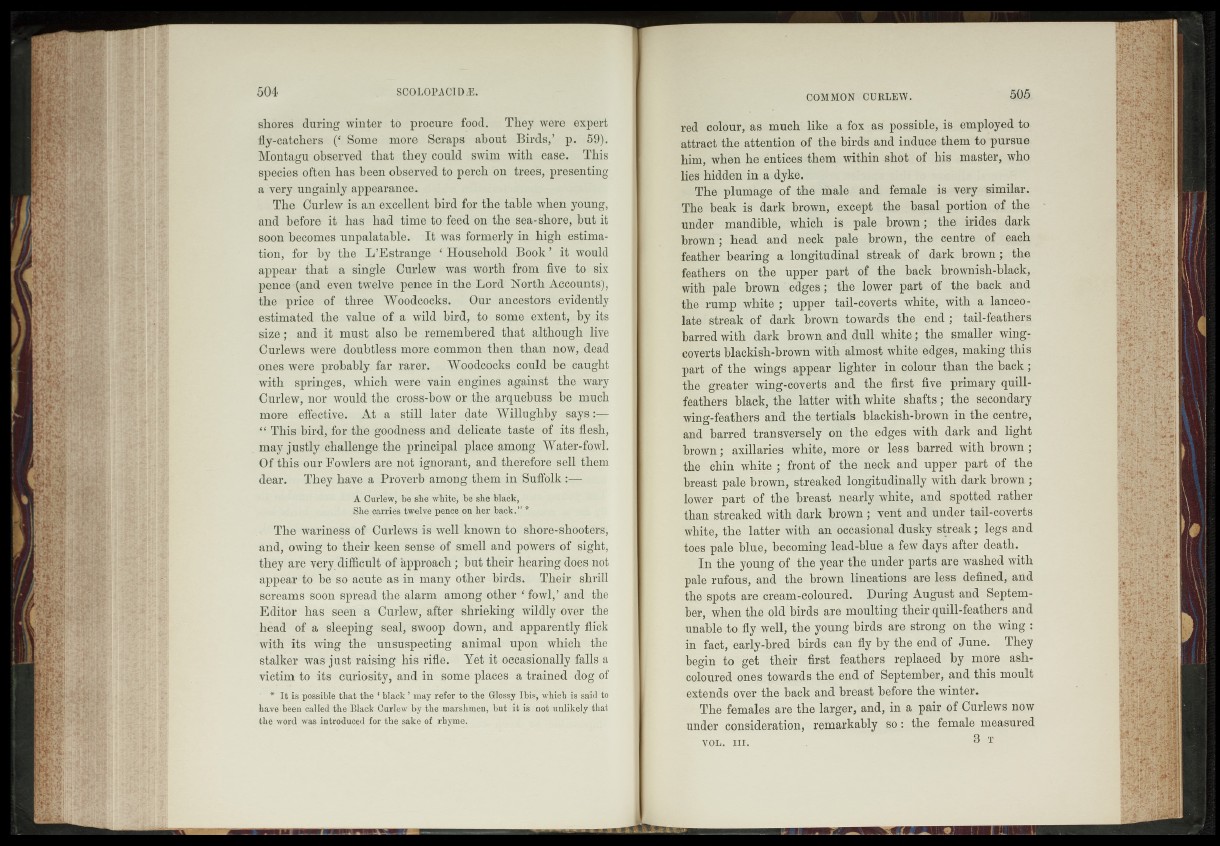
shores during winter tó procure food. They were expert
fly-càtchers (* Some more Scraps about Birds,’ p. 59).
Montagu observed that they could swim with ease. This
species often has been observed to perch on tree's, presenting
a very ungainly appearance.
The Curlew is an excellent bird for the table when young,
and before it has had time to feed on the sea-shore, but it
soon becomes unpalatable. It was formerly in high estimation,
for by the L’Estrange ‘ Household B o o k i t would
appear that a single Curlew was worth from five to six
pence’(and even twelve pence in the Lord North Accounts),
the price of three Woodcocks. Our ancestors- eyidently
estimated the value of a wild bird, to seme extent, by its
size ; and it must also be remembered that although live
Curlews were doubtless more common then than now, dead
onès were probably, far rarer. Woodcocks mould be caught
with springes, which we*e‘ vain .engforö against, the wary
Curlew, nor would the cross-bow or the arquebuse be much
more effective», At a s-tilk-dater date- Willughby says :—
“ This bird, for the goodness and delicate taste of its flesh,
may justly challenge the principal place among Water-fowl.
Of this our Fowlers are not ignorant, and therefore -se-h;them
dear. They have a Proverb among them in Bjiffolk»-^-- -
A Curlew, be she white, be sbe black,
I J&}ie.carries twelve pence 05 her back.” * u
0 The wariness of Curlews is well known to shore-shooters,
and, Owing toitheir- keen keiseml smell aniâpo^ers off éight,
they are very difficult of approach; but their hearing does-not
appear to be so acufè-as in many other -birds. Their shrill
screams soon spread th&alarm among-othersfowl,’ ,and the
Editor has seen a-'Curlew, after shrieking-imMlyiover .the
head of a sleeping seal, swoop down, and apparently I&k
with its* wing the unsuspecting .animal upon which' -the
stalker- was just raising his rifle. Yet it occasionally falls a
victim to its ; curiosity, and in some-places a trained dog-of
“ is possible that the * black ’• may refer "to the Glbssÿ' fBis, which is ’said'-to
bavé been called the hlack. Curlew- by^the -marsbaien, but itf âsüuot unlikely'tb^t
thé word was introduced for the sake of rhyme.’..
red colour, as much like a fox as possible, is employed to
attract the attention of the birds and induce them to pursue
him, when he éntices them within -shot of hie master, who
lies hidden in- a dyke.
The plnmage of the male and female is very similar.
The beak is dark brown, except the basal portion of the
under mandible, which is pale brown ; the: irides dark
brown; head and neck pale brown, the centre of each
feather bearing a longitudinal streak off dark brown ; the
feathers on the upper part of the hack brownish-black;
with pale brown edges; the lower part of the back and
the rump white'; - upper tail-coverts white, with a lanceolate;
streak of dark brown towards the end ;- tail-feathers
barred wfB| dark brown and dull; "white; the smaller wjrigg
coverts blackish-brown with almost white edges, making this
■part of the wings appear lighter in colour;than the hack;
the greater vving-cóverfl 'p,nd the first five primary quill-
feathers black, the Mtter with white shafts; the secondary
wing-feathers and thé tertiaïs blackish-brown in the centre,
and barred transversely onfthe edges with dark and light
brown; axillaries wbite, more or less barred with brown;
the chin wbite ; front of the neck and upper part of the
breast pale brown, streaked longitudjbg-lly &ÉÈj dark brown;
lower part of the' breask nearly- white^and spotted rather
than streaked with dark brown ; vent, and under tail-coverts
white, the latter with an occasional, dusky streak ; legs knd
toes pale blue, becoming lead-blue a few days after death.
In the young ok the year the under parts are washed with
pale rufous, and the brown lineations^ are leas defined, and
the spots are cream-coloured. During August and September,
when the’ old birds are moulting thei^q^rfeathers and
unable to fly well, the young birds are strong- on the wing^
in fact, early-bred birds can fly by* the enLqf-'June. They
begin to get their first feathers replaced by more ash-
keoloured ones towards the end of September, and this moult
»extends over the hack and breast before the winter»
The females are the larger, and, in a pair of Curlews now
under consideration, remarkably so : the female measured
:YOL. ‘'III. ■ a t